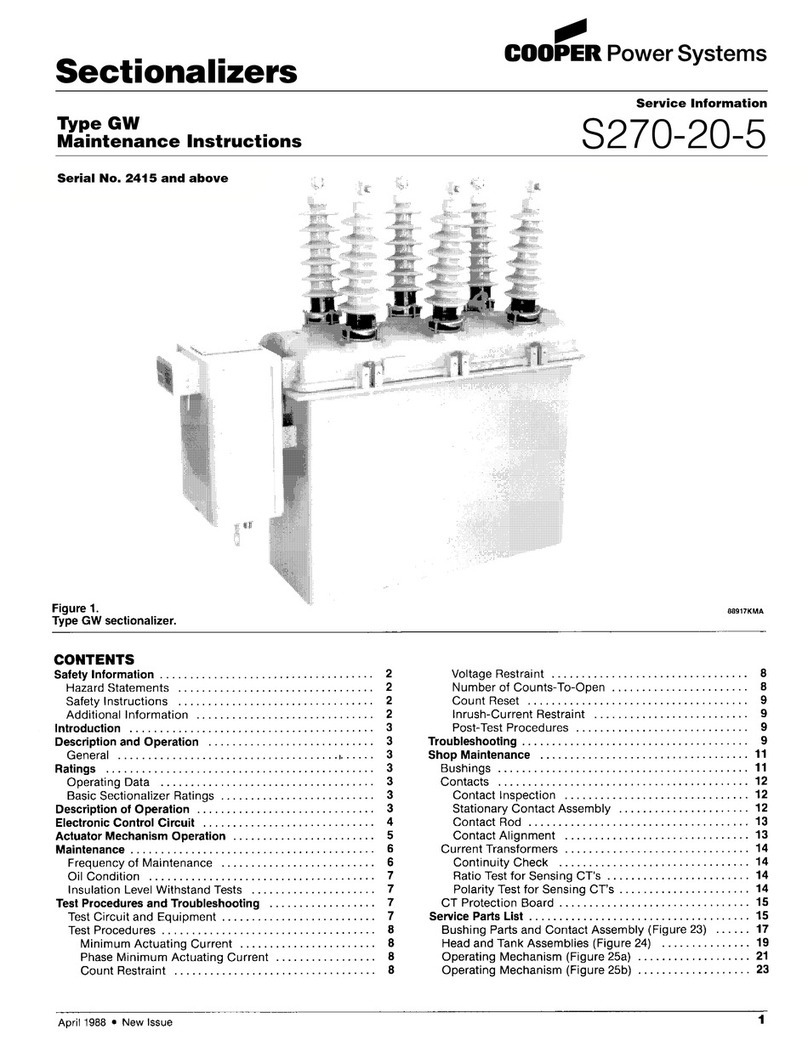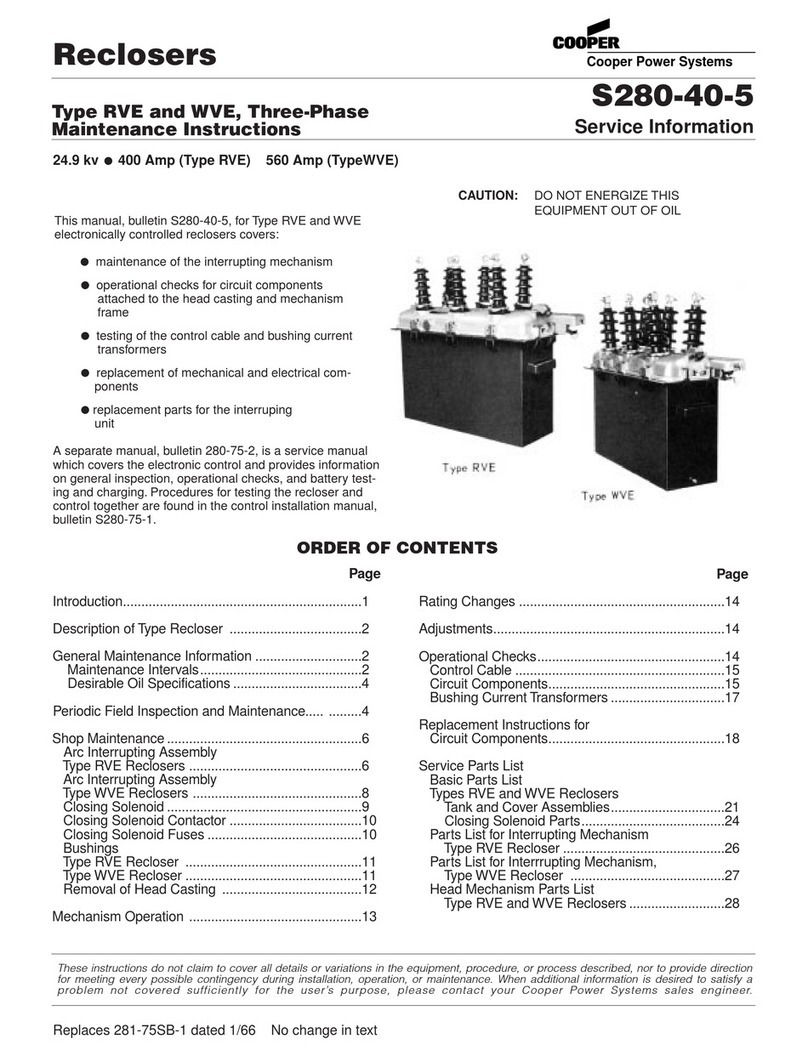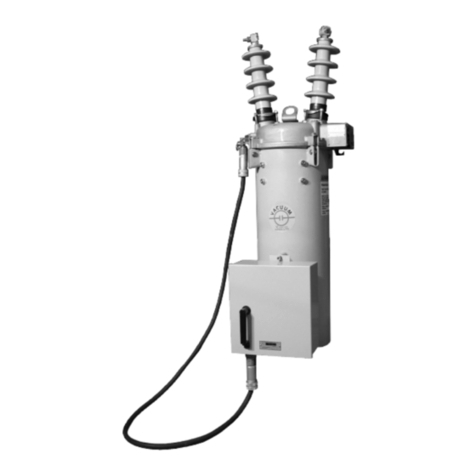
Page 4
PERIODIC INSPECTION AND MAINTENANCE
Frequency of inspection and maintenance depends upon the
local climatic conditions and the manual switching duty
imposed on the unit. The sectionalizer does not interrupt fault
currents, so contact wear and oil contamination due to arcing
will be minimal. Thus, maintenance efforts should be directed
primarily toward keeping the unit in operating order and main-
taining the dielectric strength of the insulating oil.
Cooper Power System's recommends that, initially, a mainte-
nance check be made after one year of service. A study of
maintenance records for similar equipment, along with the
results of the initial maintenance check can then be used to
establish realistic maintenance intervals.
Each periodic maintenance check should include at least the
following steps:
1. Bypass, trip and. deenergize the sectionalizer and remove it
from service.
2. Inspect the external components.
A. Check for broken or cracked bushings, paint scratches,
and other mechanical damage.
B. Close and trip the sectionalizer manually several times
to check mechanical operation. Leave the unit in the
open position.
3. Remove the bolts and clamps that secure the head casting
to the tank and remove the mechanism from the tank.
Carefully pry apart the head and tank to break the gasket
seal.
4. Allow the oil to drain off the mechanism.
5. Clean the internal components.
A. Remove all traces of carbon by wiping with a clean, lint-
free cloth.
B. Flush the hydraulic mechanism with clean transformer
oil.
6. Check the moving and stationary contacts.
A. Slight pitting and discoloration can be dressed with cro-
cus cloth or a fine-tooth file.
B. Replace the moving and stationary contacts if they are
severely eroded (see “Shop Maintenance Procedures”
section of this manual).
NOTE: The amount of erosion permissible is difficult to define.
Good judgment must be used when deciding whether to
replace the sectionalizer contacts.
7. Operate the control lever manually, and observe if all com-
ponents operate properly. When tripping the sectionalizer in
air, hold or cushion the moving contacts with one hand to
eliminate impact and overstressing of contact box.
8. Inspect tank liners. Soft or spongy areas indicate that water
has been absorbed. Replace both the tank wall
liner and tank bottom liner if this condition is detected.
NOTE: The 125-kv BIL unit has an additional wall iiner between
the standard liner and the tank which must also be replaced when
new liners are installed.
9. Check the dielectric strength of the insulating oil.
A. The dielectric strength should not be less than 22 kv
when tested with an 0.1-inch gap in accordance with
methods specified in ASTM D-117.
B. Low dielectric strength usually indicates the presence
of water or carbon deposits; replace the oil.
10. If oil must be replaced, drain the tank and clean out all
sludge and carbon deposits.
11. With the mechanism removed, fill the tank with clean insu-
lating oil to the top of the tank wall liner. Capacity is
approximately 1-1/2 gallons.
Use only new, or like-new reconditioned transformer oil
which conforms to the specifications in Cooper Power
System's Reference Data R280-90-1, “Oil Specifications
and Test”.
12. Examine the head gasket. Replace the o-ring gasket if it
has taken a permanent set.
13. Before retanking the sectionalizer, invert and prime the
hydraulic mechanism by introducing new transformer oil
with an ordinary squirt can through the hole in the bottom
of the coil frame. Then, quickly place the mechanism into
the tank far enough to cover the hydraulic mechanism with
oil. With a slender tool, such as a small Allen wrench,
push down the trip piston to clear air from the hydraulic
parts.
14. Reuse the head bolts and tank clamps and torque to 10-
14 ft -lbs. Clamping forces must be applied gradually and
equally in rotation to each bolt. This results in an evenly
distributed gasket sealing pressure.
15. Manually close and open the unit several times to expel all
air from the hydraulic system and to check the mechani-
cal operation.
16. Check if the unit is operating properly.With the sectionaliz-
er closed, momentarily connect a six-volt storage battery
across its bushing terminals. Repeat this procedure at
about one-second intervals and note if the sectionalizer
opens after the correct number of operations has
occurred. If the unit does not lock out properly, wait about
three minutes and repeat the test. Air entrapped in the
hydraulic system can cause incorrect operation.
If the unit still fails to operate properly, disassemble the
hydraulic mechanism as described in “Shop Maintenance
Procedures”. Check carefully for sludge accumulation,
dirt, or scratches on any of the parts. Clean the parts and
carefully reassemble the mechanism. Cleanliness is
very
important. Recheck the unit for proper operation.
OIL CONDITION
Oil plays an important role in the proper functioning of the
sectionalizer. It provides the internal insulation barrier from
phase-to-ground, and it acts as an arc quencher during man-
ual load switching.For effective sectionalizer operation, the
CAUTION
Never use volatile solutions, detergents, or water-soluble
cleaners.
































